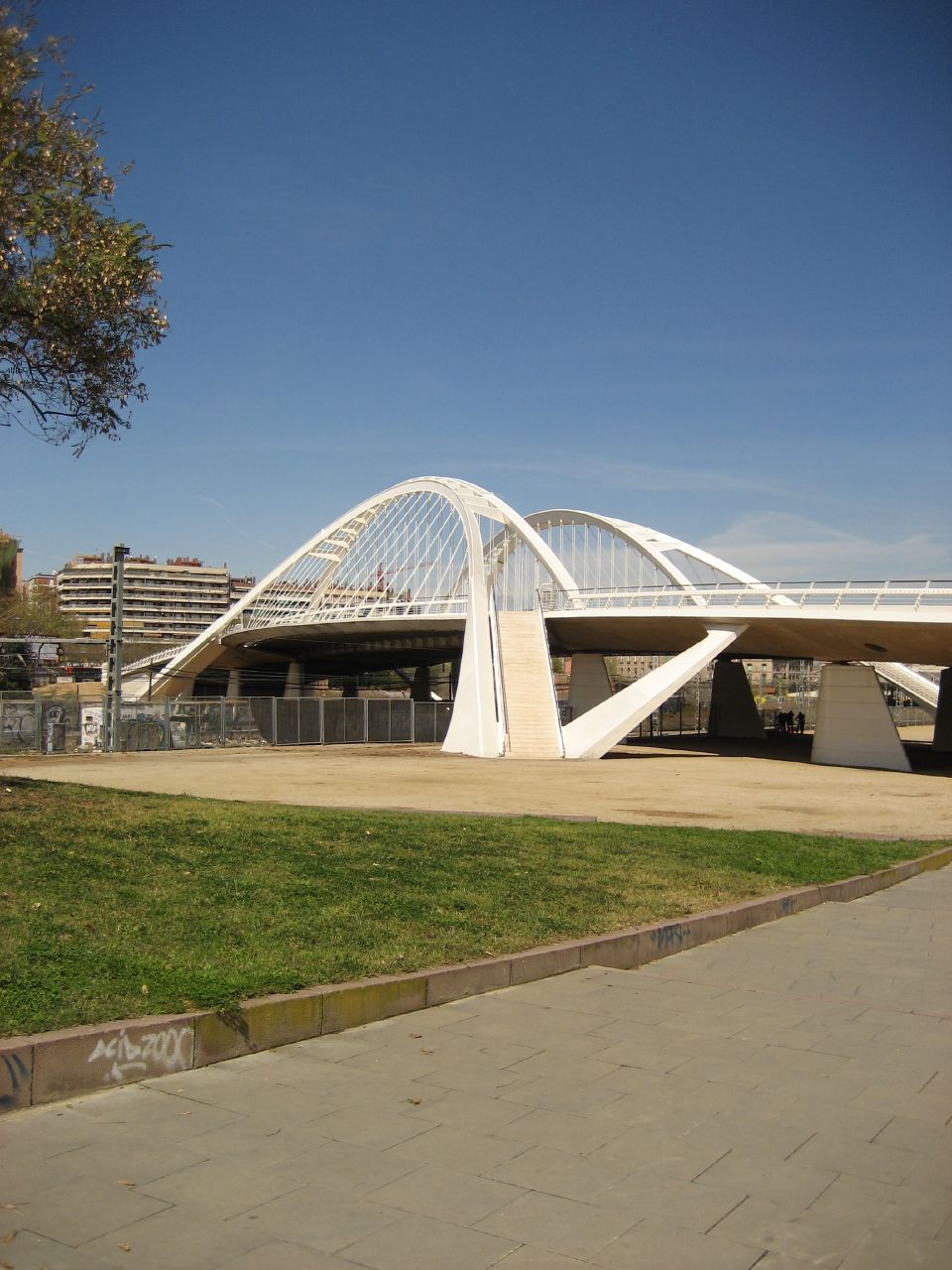Bac de Roda Bridge
After regenerating the urban fabric of the city with small- and medium-sized interventions in the first 1980s and coinciding with Barcelona's preparations for the candidature for the 1992 Olympic Games, the city started building bigger projects. It is said that the Bac de Roda Bridge (or the Calatrava Bridge as it is popularly known) was the starting point for all these bigger inerventions. The steel and concrete bridge, with its twin, pristine white, inclined and split arches, helped to unite two working-class districts at the northern part of the city that were separated by train tracks. Still, what the City Council wanted was something more than just a bridge, they wanted a symbol or an icon that reflected the new urban and political strategy to regenerate also those parts less touristy and known of Barcelona. Calatrava, though he had never built a bridge before, was chosen for the new structure (the new image). People who know about bridges say that it is much more complex (therefore expensive) than what would have been necessary -like many other Calatrava bridges around the world- but the real purpose of the project, its social impact, succeeded and the bridge became an emblem of the pre-Olympic architecture of the city. The future urbanization of the Sagrera Park, which starts at this bridge, will turn it into an obsolete structure, but the Park's masterplan not only leaves the bridge intact but includes a glass dome under it to cover the new high-speed train lines and keep the bridge's urban and social iconic status. It won the FAD Prize in 1987 in the category of Architecture (the first time an engineering work won this prize) and was a finalist for the I Mies van der Rohe Pavilion Award for European Architecture in 1988.
 Photo by catarina_555
Photo by catarina_555The Bach de Roda bridge was built as part of the revitalization of two poorer areas of Barcelona, Catalonia. Spurred on by the city's selection to host the 1992 Olympic Games, the bridge was one of the first stages of improvement for the Sant Andreu and Sant Marti areas of the city.
Along with this bridge, a new rail station was built; all part of a larger plan to improve the infrastructure of the entire city of Barcelona. As with many of Calatrava's bridges, this bridge serves both pedestrians and automobiles, giving access to parks below on either side.
To further accentuate the city, balconies allow pedestrians to stop along the bridge to enjoy a view of the city.
Along with this bridge, a new rail station was built; all part of a larger plan to improve the infrastructure of the entire city of Barcelona. As with many of Calatrava's bridges, this bridge serves both pedestrians and automobiles, giving access to parks below on either side.
To further accentuate the city, balconies allow pedestrians to stop along the bridge to enjoy a view of the city.
Bridge dimensions
· Length: 423.2 ft (129.0 m) | Max. Span: 150.9 ft (46.0 m)
· Arch Height: 32.8 ft (10.0 m) | Height over Railbed: 26.2 ft (8.0 m)
· Length: 423.2 ft (129.0 m) | Max. Span: 150.9 ft (46.0 m)
· Arch Height: 32.8 ft (10.0 m) | Height over Railbed: 26.2 ft (8.0 m)
"The bridge spans the railway tracks between the main streets 'Bac de Roda' and 'Felip II', which run from north to south, connecting the sea and the city.
· Materials and dimensions: Double arch and middle section of the road and footpath, steel; lower part of the steel arches, steel and concrete combination; abutments, white concrete; total length 180m, max. span 68m.
The twin arches widen slightly at both ends, increasing structural rigidity and permitting the passage of pedestrians on footpaths to either side. Steps follow the line of the arches on both sides of the railway. The roadway lights are in the middle of the bridge, while the footpath is lit by strip lighting integrated into handrails."
[Santiago Calatrava, Engineering Architecture, Santiago Calatrava, Birkhäuser Verlag, Basel-Boston-Berlin, 1990]
· Materials and dimensions: Double arch and middle section of the road and footpath, steel; lower part of the steel arches, steel and concrete combination; abutments, white concrete; total length 180m, max. span 68m.
The twin arches widen slightly at both ends, increasing structural rigidity and permitting the passage of pedestrians on footpaths to either side. Steps follow the line of the arches on both sides of the railway. The roadway lights are in the middle of the bridge, while the footpath is lit by strip lighting integrated into handrails."
[Santiago Calatrava, Engineering Architecture, Santiago Calatrava, Birkhäuser Verlag, Basel-Boston-Berlin, 1990]




4 comments:
Can I just say what a relief to find someone who actually knows what theyre talking about on the internet. You definitely know how to bring an issue to light and make it important. More people need to read this and understand this side of the story. I cant believe youre not more popular because you definitely have the gift.
Wow that is a famous article.. I' m take to it.. proficient post
[IMG]http://www.sedonarapidweightloss.com/weightloss-diet/34/b/happy.gif[/IMG]
Howdy! I could have sworn I've been to this web site before but after looking at some of the posts I realized it's new to me.
Anyhow, I'm definitely pleased I discovered it and I'll be bookmarking it and checking back
often!
Also visit my weblog ; weightloss blog
I appreciate how this bridge successfully connected two working-class districts.
Post a Comment